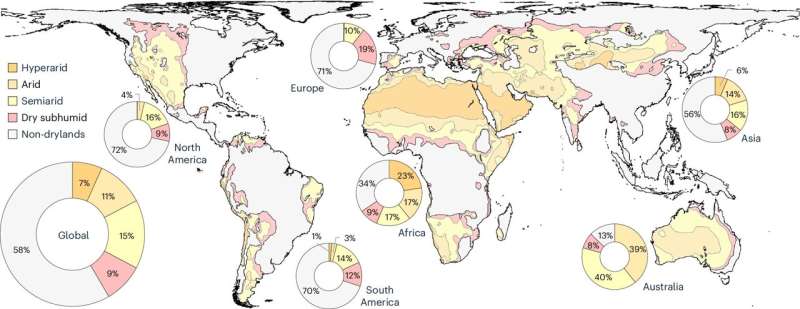This article has been reviewed according to Science X's editorial process and policies. Editors have highlighted the following attributes while ensuring the content's credibility:
fact-checked
peer-reviewed publication
trusted source
proofread
Natural drylands grossly under-protected: Study predicts major threats due to human land-use conversion

Drylands cover about 42% of the Earth's land surface and are increasingly threatened by human land-use pressures like agriculture, alternative energy sources, overgrazing and climate change. Up to a third of the global human population living in drylands might be affected by the loss of native drylands, arable land, and reduced water resources.
Moreover, it is not only people that are affected by these increasingly degraded areas—dryland species are also increasingly threatened with extinction. However, only a small fraction of drylands is slated for conservation, according to a new study by Ben-Gurion University of the Negev researchers.
Their findings were published earlier this month in the journal Nature Ecology and Evolution.
Drylands currently face considerable anthropogenic threats from agriculture, timber and plant harvesting, invasive species and disease, and infrastructure development. Despite these threats, Dr. Amir Lewin, a postdoctoral fellow under the co-supervision of Profs. Shimon Rachmilevitch and Uri Roll, shows that just 12% of drylands are covered by protected areas (considering all International Union for Conservation of Nature (IUCN) categories).
Drylands already face severe land degradation and considerable water declines, and their biodiversity is especially vulnerable to extreme heat events, resource changes and fractured habitats from human encroachment.
Non-dryland regions are better covered with 21% coverage of protected areas, although both drylands and non-drylands fall well below the target of 30% protection of the Earth's surface by 2030 set by the Convention on Biological Diversity (CBD). Such gaps in protected area coverage have particularly important implications in Africa and Asia, which contain the largest areas of global drylands.
The 12% degree of protection drops even lower when you drill down into IUCN category rankings—less than 5% of some of the most biodiverse dryland areas are being managed strictly for biodiversity protection. That translates to less than 10% of most species' habitats dedicated to conservation (probably the very minimum degree of protection for maintaining viable populations). This includes many vertebrate species and dryland endemic species found nowhere else in the world with 0% protection.
Beyond poor current protection, drylands are projected to undergo severe man-made changes during the 21st century. Under different future carbon emission and economic development scenarios by 2100, most drylands across continents are projected to be converted to some degree due to urban, agricultural, and alternative energy expansion. This is true even under optimistic scenarios that aim to reduce global agricultural land coverage and promote progressive climate policies,
"This represents an urgent and alarming call for expanding the protection of hundreds of amphibian, bird, mammal and reptile species, and the preservation of valuable ecological systems in drylands. At the same time, drylands provide unique opportunities and significant scope for achieving conservation and biodiversity goals globally. However, if we fail to act soon, then there won't be much left to save," says Lewin.
"To date, most global attention has neglected drylands as priorities for conservation. Our work highlights both the lack of protection towards drylands, and their grim future due to human actions during the 21st century. Hopefully, our work will help turn international focus towards drylands and the unique life they contain," added Prof. Rachmilevitch.
"Humans have long looked at deserts for inspiration and livelihood. It is now time we also acknowledge that unless we act today, these unique landscapes will be lost tomorrow," concluded Prof. Roll.
Dr. Lewin, Prof. Rachmilevitch and Prof. Roll are members of the Jacob Blaustein Institutes for Desert Research and the Goldman Sonnenfeldt School for Sustainability and Climate Change at Ben-Gurion University of the Negev. Dr. Gopal Murali, another co-author of this work, is a member of the Department of Ecology and Evolutionary Biology, University of Arizona.
More information: Amir Lewin et al, Global evaluation of current and future threats to drylands and their vertebrate biodiversity, Nature Ecology & Evolution (2024). DOI: 10.1038/s41559-024-02450-4
Journal information: Nature Ecology & Evolution
Provided by Ben-Gurion University of the Negev





















